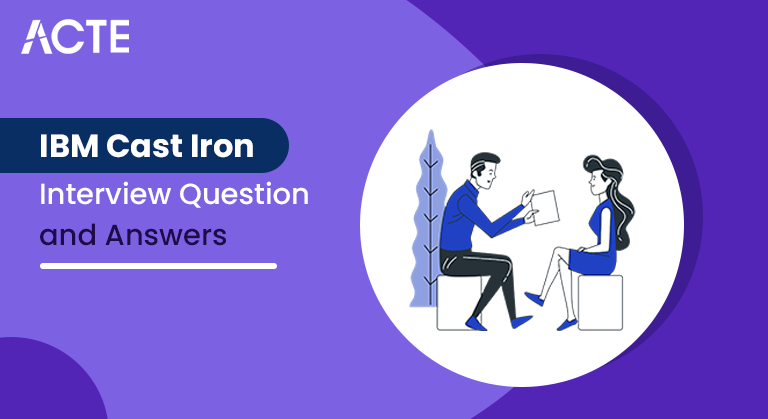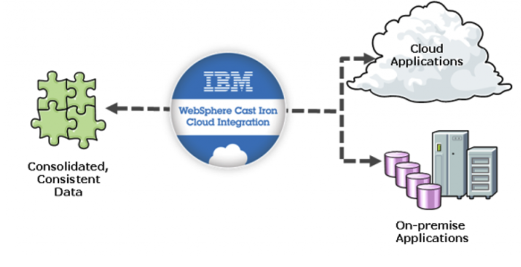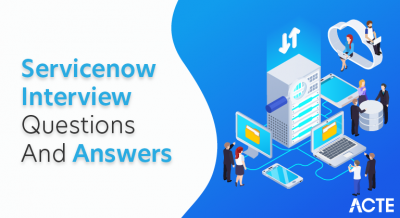
IBM Cast Iron, now part of the IBM App Connect family, is a robust integration platform designed to streamline the connection of disparate applications, systems, and data sources within an enterprise. Known for its user-friendly approach, Cast Iron employs a graphical Design Studio that allows integration developers to visually design, configure, and manage integration flows through a drag-and-drop interface. This configuration-based method, coupled with a library of pre-built connectors for popular applications and databases, accelerates the development of integration projects without the need for extensive coding.
1. What are Cast Iron Systems?
Ans:
IBM Cast Iron Systems is a cloud integration solution developed by IBM to streamline and automate the integration of diverse applications, systems, and data across an enterprise’s hybrid cloud environment. Cast Iron offers a comprehensive platform that facilitates seamless connectivity between on-premises applications and cloud-based services. This integration tool enhances efficiency and agility by orchestrating business processes and data flows.
2. What specific functionalities do Cast Iron Systems offer?
Ans:
- Cast Iron Systems was historically known for its cloud integration solutions, providing tools and platforms to integrate applications and data seamlessly across diverse environments.
- These solutions often aimed to streamline business processes by enabling efficient communication and data flow between on-premises systems and various cloud services.
- Additionally, Cast Iron Systems typically offered pre-built connectors and templates to accelerate integration projects, supporting common business applications, databases, and services.
3. What is Software as a Service?
Ans:
Software as a Service (SaaS) is a cloud computing model that delivers software applications over the internet, allowing users to access and use the software through the web browser without needing local installation or maintenance. In the SaaS model, software providers host and keep the applications, handle updates, and manage the infrastructure while users subscribe to the service on a subscription basis.
4. What is the use of cast iron?
Ans:
Cloud Integration: Cast Iron facilitated the integration of on-premises applications with different cloud-based applications and services, enabling seamless data flow between various environments.
Data Migration: It supported migration and transformation tasks, allowing organizations to move info efficiently between on-premises and cloud platforms.
Business Process Automation: Cast Iron Systems helped automate business processes by orchestrating workflows and integrating various systems. This could include order processing, customer onboarding, or other business-critical processes.
5. What specific advantages might IBM experience from this?
Ans:
- Enhanced Cloud Integration
- Expanded Service Portfolio
- Increased Market Competitiveness
- Accelerated Integration Projects
- Support for Business Transformation
- Improved Customer Satisfaction
6. What is IBM Cast Iron?
Ans:
IBM Cast Iron was a cloud-based integration platform provided by IBM. It was designed to simplify integrating diverse applications, data sources, and services within hybrid cloud environments. IBM Cast Iron aimed to facilitate seamless communication and data flow between on-premises systems and various cloud services.
7. In which situations may the IBM Cast Iron be used?
Ans:
Hybrid Cloud Integration: Organizations operating in hybrid cloud environments, using a combination of on-premises and cloud-based applications, can utilize IBM Cast Iron to integrate and synchronize data seamlessly between these environments.
Application Integration: When there is a need to connect and integrate different business applications, such as Customer Relationship Management (CRM), Enterprise Resource Planning (ERP), and other software solutions to ensure a unified and efficient workflow.
Partner and Vendor Integration: When collaborating with external partners or vendors, IBM Cast Iron can establish seamless connections, enabling the secure exchange of data and information.
8. Explain Cast Iron’s role in hybrid cloud environments.
Ans:
IBM Cast Iron plays a significant role in hybrid cloud environments by facilitating seamless integration between on-premises systems and various cloud-based applications and services. Hybrid cloud environments involve a combination of on-premises infrastructure and cloud resources, and Cast Iron is designed to address the challenges associated with integrating and coordinating operations across these diverse environments.
9. What are the key benefits of using Cast Iron for integration?
Ans:
Cast Iron offers compelling advantages:
- Accelerated integration timelines
- Reduced complexity
- Enhanced scalability

10. What advantages do Cast Iron System’s business partners stand to gain?
Ans:
Simplified Integration Processes: Cast Iron Systems provides a user-friendly integration platform with pre-built connectors and templates.
Reduced Time-to-Market: With Cast Iron’s pre-built connectors and templates, business partners can expedite the development and deployment of integration projects.
Scalability: Cast Iron supports scalable integration solutions, allowing business partners to adapt to changing business requirements and accommodate growth.
11. How does Cast Iron support different data formats?
Ans:
Cast Iron boasts versatile support for various data formats such as XML, JSON, and flat files. This flexibility ensures that the platform can handle diverse data types seamlessly during integration processes, accommodating the varied needs of connected systems. Additionally, Cast Iron’s mapping capabilities allow users to define and customize data transformations, making it adaptable to the unique structures of diverse data formats.
12. How does Cast Iron ensure data security during integration processes?
Ans:
Encryption: Cast Iron typically uses encryption protocols to secure data during transmission.
Authentication: Robust authentication mechanisms are employed to verify the identities of users and systems involved in the integration.
Authorization: Role-based access control (RBAC) is commonly implemented to define and enforce permissions for different users or systems.
13. What are “orchestrations” in Cast Iron?
Ans:
Cast Iron is not specifically associated with the term “orchestrations.” However, in the context of integration and middleware solutions, orchestrations generally refer to the coordination and automation of multiple tasks or processes within a workflow. In this context, orchestrations in Cast Iron could represent the sequence of activities involved in integrating various applications or systems.
14. What are the differences between Cast Iron and traditional point-to-point integration.
Ans:
| Aspect | Cast Iron | Traditional Integration | |
| Development Approach |
Graphical Design Studio, configuration |
Custom coding, often script-based | |
| Ease of Use | Intuitive drag-and-drop interface | Requires specialized coding skills | |
| Scalability |
Centralized approach, scalable |
Less scalable, complex with individual connections | |
| Connectivity | Pre-built connectors library | Custom code for each connection |
15. How does Cast Iron achieve real-time data integration?
Ans:
- Cast Iron, now known as IBM App Connect, achieves real-time data integration through a combination of pre-built connectors, a scalable architecture, and a robust transformation engine.
- The platform provides a wide range of connectors that facilitate seamless integration with various applications, databases, and systems.
16. Explain Cast Iron design studio in integration projects.
Ans:
Cast Iron Design Studio specializes in seamless integration projects, offering expertise in crafting cohesive and functional designs across various platforms. Their approach involves a meticulous understanding of client needs and a keen focus on user experience, ensuring smooth transitions and efficient workflows.
17. What are the deployment options for IBM Cast Iron?
Ans:
IBM Cast Iron offers various deployment options to meet diverse integration needs. It can be deployed on-premises, allowing organizations to maintain control over their infrastructure and data. Additionally, Cast Iron provides:
- A cloud-based deployment option.
- Enabling users to leverage the benefits of scalability.
- Flexibility.
- Reduced maintenance associated with cloud platforms.
18. How does Cast Iron support data transformation during integration?
Ans:
Cast Iron, an integration platform, facilitates data transformation during integration by providing a comprehensive set of tools and features. It supports the mapping and conversion of data between disparate systems, ensuring seamless communication. With built-in data mapping capabilities, Cast Iron allows users to define transformation rules and manipulate data formats to align with the requirements of the target system.
19. What kinds of services do cast iron systems offer?
Ans:
Real-time Integration: Supporting real-time data integration, ensuring that information across connected systems is up-to-date.
Monitoring and Management Tools: Offering tools for monitoring and managing integration processes. This allowed organizations to track their integrations’ performance and promptly address issues.
20. How does Cast Iron handle errors during integration processes?
Ans:
Cast Iron, IBM’s integration platform, employs a robust error-handling mechanism to ensure seamless integration processes. It features comprehensive monitoring capabilities that track the flow of data between applications and systems. In the event of errors, Cast Iron provides real-time alerts and notifications, allowing administrators to address issues promptly.
21. Explain “Connectors” in IBM Cast Iron.
Ans:
In IBM Cast Iron, connectors play a crucial role in facilitating seamless integration between disparate applications and systems. These connectors serve as the bridge between different software solutions, enabling them to communicate and share data efficiently. IBM Cast Iron’s connectors are pre-built adapters designed to connect specific applications or services, streamlining the integration process and reducing development time.
22. What is a Cast Iron management console?
Ans:
The Cast Iron management console is a centralized tool for monitoring and managing integration processes. The Cast Iron management console” in the technology or management domain. It provides real-time insights into the performance and status of deployed integrations, aiding administrators in maintaining optimal system health.
23. How does Cast Iron handle versioning and updates in integration projects?
Ans:
Cast Iron, IBM’s integration platform, handles versioning and updates in integration projects through a structured approach. It employs version control mechanisms, allowing users to manage different versions of integration flows.
Users can create and maintain multiple versions of their integration projects, enabling them to make changes and updates without affecting existing implementations.
24. Can Cast Iron integrate with legacy systems?
Ans:
Yes, Cast Iron is designed to integrate seamlessly with legacy systems. It employs a variety of connectors and adaptors that facilitate communication between modern and legacy applications. Cast Iron ensures compatibility through its extensive library of pre-built templates for common integration scenarios, allowing easy mapping and transformation of data between different systems.
25. Explain Cast Iron Live API in integration projects.
Ans:
- The Cast Iron Live API is a gateway for external applications to interact with Cast Iron orchestrations.
- It allows seamless integration with third-party services and applications, enhancing the platform’s extensibility and versatility.
- Cast Iron Live API supports both cloud-based and on-premise integrations, ensuring adaptability to various IT environments.
26. How does Cast Iron facilitate connectivity with on-premises systems?
Ans:
Cast Iron provides on-premises connectivity through its Secure Connector, establishing a secure link between the cloud-based integration platform and internal systems. This ensures seamless integration and data exchange while maintaining security protocols. Cast Iron also offers a user-friendly interface for designing and managing integration workflows.
27. Can Cast Iron handle large volumes of data during integration?
Ans:
Yes, cast iron is designed to reduce volumes of data during intelligent rationing processes. Its scalable architecture enables organizations to seamlessly manage and integrate substantial information between applications and systems, ensuring high-performance data processing. With support for various data formats and protocols, Cast Iron facilitates the integration of data-intensive applications.
28. How does Cast Iron handle data transformation in real-time scenarios?
Ans:
Cast Iron excels in real-time data transformation through its dynamic mapping capabilities. This allows for on-the-fly data transformation during integration, ensuring agility and responsiveness in rapidly changing business scenarios. Cast Iron efficiently adapts to evolving data requirements, making it a versatile solution for real-time integration challenges.
29. What security measures does Cast Iron employ for data in transit and at rest?
Ans:
- Cast Iron prioritizes data security by employing industry-standard encryption protocols for data in transit.
- Additionally, data at rest is secured through access controls, ensuring end-to-end protection throughout the integration process.
- Access controls and authentication mechanisms are also implemented to regulate and authenticate users, adding an extra layer of security for data storage.
30. Can Cast Iron orchestrate workflows involving multiple systems and applications?
Ans:
Yes, Cast Iron is capable of orchestrating workflows involving multiple systems and applications. It is an integration solution offered by IBM that facilitates seamless connectivity and data flow between diverse software applications, databases, and services. Cast Iron’s intuitive design allows users to create and manage complex workflows.
31. How does Cast Iron handle compliance with industry regulations?
Ans:
- Cast Iron adheres to industry regulations by providing audit trails and compliance reporting features.
- These features enable organizations to maintain transparency and demonstrate adherence to regulatory requirements during integration processes.
- Regular updates and monitoring help maintain alignment with evolving regulatory requirements.
32. What security measures does Cast Iron employ for data protection?
Ans:
Cast Iron, an integration platform, employs robust security measures to ensure data protection. It utilizes industry-standard encryption protocols such as SSL/TLS to secure data transmission, safeguarding information in transit. Additionally, access controls and authentication mechanisms are implemented, limiting system access to authorized personnel only.
33. Explain Cast Iron’s template-based approach in accelerating integration projects.
Ans:
- Cast Iron’s template-based approach involves using pre-built templates for common integration scenarios.
- This accelerates project development by providing a foundation that developers can customize, significantly reducing the time and effort required for integration implementation.
34. What is Integration with External Databases?
Ans:
Cast Iron integrates with external databases through its robust connectors, facilitating data exchange between various database systems and ensuring a unified data environment. This approach promotes a more comprehensive understanding of data, reduces redundancy, and facilitates collaborative efforts by breaking down data silos.
35. What is Handling Batch Processing in Cast Iron?
Ans:
- Handling batch processing in Cast Iron involves managing and executing multiple data transactions simultaneously.
- Cast Iron, an integration platform, allows users to process data in batches, streamlining the handling of large volumes of information.
- Users can define specific rules and conditions for batch processing, ensuring efficient data synchronization between different applications and systems.
36. What is the Role of Cast Iron Templates in Development?
Ans:
Cast Iron templates are reusable patterns for integration projects, enabling developers to accelerate development by leveraging pre-configured solutions. This templated approach ensures consistency and best practices across integration initiatives. Cast iron templates also facilitate collaboration among developers by offering a common framework for design and implementation.
37. Explain Security Measures for API Integration.
Ans:
Authentication: Implement strong authentication mechanisms, such as API keys, OAuth tokens, or JWTs, to ensure that only authorized entities can access your API.
Encryption: Employ secure communication channels (HTTPS) to encrypt data in transit, safeguarding sensitive information from interception and unauthorized access.
Rate Limiting: Enforce rate limiting to prevent abuse or excessive use of your API, ensuring fair usage and protecting against denial-of-service attacks.
38. What are Asynchronous vs. Synchronous Integrations in Cast Iron?
Ans:
Cast Iron supports both asynchronous and synchronous integrations. While asynchronous integrations allow for flexible data exchanges at different speeds, synchronous integrations enable real-time, immediate communication between systems. Cast Iron facilitates both types of integrations, allowing users to choose the most suitable approach based on their specific requirements and system characteristics.
39. What is the Role of Cast Iron in B2B Integration?
Ans:
Cast Iron plays a crucial role in Business-to-Business (B2B) integration by providing the tools to connect and exchange data with external business partners seamlessly. This capability streamlines collaboration and enhances supply chain efficiency. This integration technology enhances overall efficiency, reduces manual errors, and accelerates business processes.
40. What are Error Recovery Strategies in Cast Iron?
Ans:
Cast Iron offers error recovery strategies, including retry mechanisms and automated alerts. This ensures the resilience of integration processes, allowing the system to recover gracefully from transient errors.These strategies typically involve identifying and analyzing the root causes of errors, implementing corrective measures, and ensuring the production of high-quality cast iron components.
41. What is the support for RESTful APIs in Cast Iron?
Ans:
- Cast Iron provides robust support for RESTful APIs, enabling seamless integration with modern web services.
- This support allows organizations to connect with a wide array of web-based applications and services.
- The platform’s robust capabilities empower users to design, deploy, and monitor RESTful API integrations, ensuring smooth interoperability.
42. Explain Integration with IoT Devices in Cast Iron.
Ans:
Cast Iron is an integration platform that facilitates seamless connectivity between different applications and systems, including IoT devices. Through Cast Iron’s capabilities, organizations can easily integrate and orchestrate data flows between IoT devices and various applications, enabling efficient data exchange and automation. Cast Iron supports standard IoT protocols, ensuring compatibility with a wide range of devices.
43. What are Enhancements in the Latest Cast Iron Version?
Ans:
- The latest version of Cast Iron introduces enhancements such as improved performance, additional connectors, and advanced security features.
- Staying up-to-date with the latest version ensures access to the latest tools and optimizations for integration projects.
- These sources typically highlight new features, improvements, and bug fixes in the latest version.
44. Can Cast Iron integrate with ERP systems?
Ans:
Yes, Cast Iron supports ERP integrations through dedicated connectors. Common challenges include data format disparities, differing data models, and the need for efficient synchronization which Cast Iron addresses through its mapping and transformation capabilities. Cast Iron’s pre-built connectors and adaptors simplify the integration process.
45. How can Cast Iron be incorporated into a CI/CD pipeline?
Ans:
Version Control Integration: Incorporate Cast Iron into your CI/CD pipeline by connecting it to your version control system (e.g., Git).
Automated Testing: Implement automated testing for Cast Iron processes within your CI/CD pipeline.
Continuous Integration: Set up continuous integration triggers to build and validate Cast Iron projects automatically whenever changes are committed to the repository.
46. Can Cast Iron integrate with cloud-based storage services?
Ans:
Yes, Cast Iron offers connectors for popular cloud-based storage services, enabling seamless integration with platforms such as Amazon S3 and Azure Blob Storage, providing versatile data storage options for integrated systems. Its robust connectivity options make it well-suited for organizations seeking to leverage cloud-based storage solutions as part of their overall integration strategy.
47. How does Cast Iron implement role-based access control?
Ans:
- Cast Iron provides role-based access control, allowing administrators to define user roles with specific permissions.
- This ensures that only authorized users can modify or access critical integration configurations, enhancing overall system security.
- Administrators usually have full control over configurations, while developers have access to design and modify integrations.
48. How can Cast Iron handle large-scale data migrations?
Ans:
Cast Iron utilizes batch processing and parallel execution capabilities to handle large-scale data migrations efficiently. Strategies such as phased migrations or running parallel environments can minimize downtime during complex migration projects. Cast Iron’s scalability allows it to manage high volumes of data, and its monitoring tools enable real-time tracking.
49. What monitoring and reporting tools are available in Cast Iron?
Ans:
- Management Console
- Logging and Auditing
- Alerts and Notifications
- Error Handling and Retry Mechanisms
- Performance Monitoring
50. Explain endpoint configurations in Cast Iron.
Ans:
Endpoint configurations in Cast Iron define the connection details to various applications or data sources. They include information such as URLs, authentication credentials, and other settings required to establish a connection. Endpoints serve as the entry or exit points for data within Cast Iron, enabling the platform to interact with diverse systems.
51. Can Cast Iron integrate with APIs and web services?
Ans:
Yes, Cast Iron supports integration with APIs and web services. It can consume and expose RESTful and SOAP-based web services, making it versatile for connecting to a wide range of applications and systems. With Cast Iron, organizations can efficiently orchestrate and automate workflows across different platforms and services.
52. How does Cast Iron handle data transformation between various character?
Ans:
- Cast Iron offers built-in functions for handling character encoding and data format transformations.
- Users can specify encoding types and utilize functions to ensure seamless transformation between the various formats.
- Cast Iron supports a wide range of data transformation functions, such as parsing, validation, and formatting.
53. What is Cast Iron live API in cloud integration scenarios?
Ans:
The Cast Iron live API allows real-time integration with cloud-based applications. It enables instant data updates between the connected systems, supporting scenarios where real-time synchronization is crucial. It offers pre-built connectors and tools to streamline integration processes between on-premises and cloud applications.
54. What are the considerations for monitoring and logging in Cast Iron?
Ans:
- Cast Iron provides built-in monitoring and logging capabilities to track the execution of integrations.
- Users can configure logging levels, set up alerts for specific events, and use the monitoring dashboard to gain insights into the integration performance.
55. How can Cast Iron integrations be version-controlled and managed?
Ans:
Version Control System (VCS): Utilize a VCS such as Git to track changes in Cast Iron integration projects.
Scripting and Code Export: Leverage scripting capabilities within Cast Iron to generate code representations of integrations.
Continuous Integration (CI): Implement CI practices to automate the build and testing of Cast Iron integrations.
56. How does Cast Iron handle connectivity to SaaS applications like Salesforce?
Ans:
Cast Iron, now known as IBM App Connect, facilitates connectivity to SaaS applications such as Salesforce through pre-built connectors. These connectors enable seamless integration between Cast Iron and Salesforce, allowing for the exchange of data and workflows. Cast Iron supports a range of standard protocols and APIs, ensuring compatibility with various SaaS platforms, including Salesforce, to streamline data integration and business processes.
57. How does Cast Iron support data synchronization between different applications?
Ans:
- Cast Iron facilitates data synchronization through its real-time integration capabilities.
- Orchestrations can be designed to respond immediately to data changes, ensuring synchronized information across connected systems.
- It provides pre-built templates and reusable integration patterns, streamlining the synchronization process.
58. What security measures does Cast Iron employ for data in transit?
Ans:
Cast Iron ensures data security through encryption mechanisms for data in transit. Additionally, sensitive information, such as credentials, is securely stored, and access controls are implemented to protect data at rest. Cast Iron’s commitment to data security encompasses a comprehensive approach to protecting information throughout its lifecycle.
59. Can Cast Iron integrate with custom APIs and proprietary protocols?
Ans:
- Yes, Cast Iron provides flexibility by supporting custom APIs and proprietary protocols.
- It allows users to create custom connectors to integrate with applications that might have unique communication requirements.
- This flexibility makes it a suitable solution for organizations with unique technological landscapes.
60. How does Cast Iron handle data transformation between various character encodings?
Ans:
Cast Iron offers built-in functions for handling character encoding and data format transformations. Users can specify encoding types and utilize functions to ensure seamless transformation between the various formats. Cast Iron supports a wide range of data transformation functions, such as parsing, validation, and formatting.
61. What security measures does Cast Iron employ for user authentication?
Ans:
Cast Iron employs user authentication mechanisms, including username/password authentication and integration with LDAP or Active Directory for single sign-on. Organizations can enhance security by implementing strong password policies, restricting access based on roles, and regularly reviewing user permissions. Integration with identity providers adds an extra layer of security.
62. Explain Cast Iron’s “Try, Catch, and Finally” activities in orchestrations.
Ans:
- “Try” represents a block of activities where the main operations are executed.
- “Catch” is designed to handle exceptions that may occur during the “Try” phase, allowing for custom error handling and recovery mechanisms.
- The “Finally” block contains activities that are guaranteed to be executed, regardless of whether an exception occurred or not.
63. Elaborate on Cast Iron’s support for message queues.
Ans:
Cast Iron supports message queues, allowing organizations to implement asynchronous processing and decouple systems. By integrating with message queues like IBM MQ or Apache Kafka, Cast Iron enhances scalability and reliability. Orchestrations can be designed to publish and consume messages, ensuring efficient handling of high volumes of data and providing fault tolerance by allowing systems to process messages at their own pace.
64. What security measures does Cast Iron employ for user authentication?
Ans:
- Cast Iron employs user authentication mechanisms, including username/password authentication and integration with LDAP or Active Directory for single sign-on.
- Organizations can enhance security by implementing strong password policies, restricting access based on roles, and regularly reviewing user permissions.
65. How does Cast Iron handle data deduplication and data cleansing?
Ans:
Cast Iron offers data transformation functions that facilitate deduplication and cleansing during integration. Users can employ functions such as filtering, sorting, and merging to remove duplicate records and clean up data. Orchestrations can be designed to include these transformations, ensuring that only clean and deduplicated data is processed and synchronized across different systems.
66. What role do Cast Iron transformations play in data mapping?
Ans:
Cast Iron transformations play a crucial role in data mapping by facilitating the seamless integration and transformation of data between disparate systems. These transformations serve as the bridge between source and target data structures, ensuring compatibility and consistency. They enable the manipulation, enrichment, and cleansing of data, aligning it with the requirements of the target system.
67. Explain Cast Iron’sShared Web Services.
Ans:
- Cast Iron’s “Shared Web Services” allow users to create and expose custom web services that encapsulate specific integration logic.
- These web services can then be consumed within orchestrations or by external systems.
- This facilitates a service-oriented architecture, where integrations are encapsulated as reusable services.
68. Can Cast Iron integrate with RESTful APIs?
Ans:
Yes, Cast Iron seamlessly integrates with RESTful APIs. It provides features for consuming and exposing RESTful services, allowing organizations to connect to a wide range of web-based applications and services efficiently. The platform’s visual development environment simplifies the process of mapping data and orchestrating workflows between different endpoints, facilitating efficient RESTful API integration within a few clicks.
69. What considerations should be taken into account when configuring Cast Iron?
Ans:
Configuring Cast Iron for high availability involves deploying redundant configurations and appliances. This ensures uninterrupted service by minimizing downtime during failures. Best practices include redundant configurations and regular backups to facilitate quick recovery and maintain continuous availability.
70. Explain Cast Iron’s “Data Sheet” in orchestrations.
Ans:
- Cast Iron’s “Data Sheet” is a feature that facilitates efficient data handling by providing an in-memory representation of data.
- It optimizes processing by eliminating the need to load the entire dataset into memory, enhancing the performance of orchestrations dealing with large volumes of data.
71. List a few benefits of SaaS.
Ans:
Cost Efficiency: Software as a Service (SaaS) eliminates the need for organizations to invest heavily in hardware, infrastructure, and software licenses.
Accessibility and Convenience: SaaS applications are typically accessed through a web browser, providing users with the flexibility to access software from any device with an internet connection.
72. Does SaaS have any drawbacks at all?
Ans:
SaaS has several drawbacks despite all of its advantages. Businesses that use many SaaS applications may experience integration issues along the way. Since an outsider is handling the procedure, security is yet another big worry. Businesses should acknowledge and abide by the government’s regulations. Customization options may be limited compared to on-premises solutions, potentially restricting specific user requirements.
73. Mention certain SaaS applications.
Ans:
- Google Apps
- Concur
- Amazon Web Services
- Zendesk
- DocuSign
- Slack
74. Explain Cast Iron’s “Retry” mechanism in orchestrations.
Ans:
Cast Iron’s “Retry” mechanism allows developers to configure automatic retries for specific activities in orchestrations. This enhances error handling by providing resilience against transient issues, ensuring that failed activities are retried based on defined criteria, leading to more robust and fault-tolerant integrations. This ensures that transient errors or temporary disruptions do not cause the entire orchestration to fail.
75. What are the key components of the Cast Iron System?
Ans:
- Cast Iron Studio
- Cast Iron Live
- Cast Iron Appliances
- Connectivity Adapters
- Transformation Maps
76. How does Cast Iron handle real-time event-driven integrations?
Ans:
Cast Iron, IBM’s integration platform, excels in real-time event-driven integrations by offering a comprehensive set of connectors and pre-built templates. Its event-driven architecture enables seamless communication between applications, systems, and services. Cast Iron leverages a variety of protocols and standards, ensuring compatibility with diverse technologies.
77. What considerations are needed for optimizing the Cast Iron orchestrations?
Ans:
- Optimizing performance in Cast Iron orchestrations involves considerations such as configuring parallel processing, implementing efficient data filtering, and optimizing resource utilization.
- By leveraging these features, organizations can ensure that orchestrations efficiently handle high transaction volumes, providing optimal performance and responsiveness in integration processes.
78. How does Cast Iron handle real-time event-driven integrations?
Ans:
Cast Iron, IBM’s integration platform, excels in real-time event-driven integrations by offering a comprehensive set of connectors and pre-built templates. Its event-driven architecture enables seamless communication between applications, systems, and services. Cast Iron leverages a variety of protocols and standards, ensuring compatibility with diverse technologies.
79. How can Cast Iron be configured to handle dynamic decision-making?
Ans:
- To configure Cast Iron for dynamic decision-making in integrations, leverage its built-in capabilities, such as conditional statements and branching logic.
- Utilize variables and data mappings to adapt dynamically to changing conditions during runtime.
- Employ decision activities to define rules and criteria, allowing the integration to make real-time decisions based on incoming data.
80. What are Cast Iron’s global variables in orchestrations?
Ans:
Cast Iron’s global variables play a crucial role by allowing the persistence of information across different steps in orchestrations. They contribute to maintaining the state and enabling dynamic decision-making, providing flexibility in responding to changing conditions during integration processes. They provide a centralized mechanism for managing dynamic data that needs to persist throughout the orchestration flow.
81. What is Cast Iron’s support for error recovery strategies?
Ans:
- Cast Iron, often referred to as IBM WebSphere Cast Iron is an integration platform designed to connect various applications and systems.
- While it does not provide explicit error recovery strategies, it incorporates features to enhance fault tolerance and error handling.
- Cast Iron supports transactional processing, allowing for the rollback of incomplete transactions in case of errors.
82. Explain Cast Iron’s monitoring dashboard in integration processes.
Ans:
Cast Iron’s monitoring dashboard in integration processes provides real-time visibility into data flows and system interactions. It offers a comprehensive overview of integration performance, highlighting successful transactions and potential issues. The dashboard allows users to track key metrics, such as processing times and error rates, enabling quick identification and resolution of issues.
83. How does Cast Iron handle versioning in integrations?
Ans:
- Cast Iron supports versioning through export/import functionalities. Best practices involve maintaining version control, documenting changes, and thorough testing in a non-production environment.
- This ensures smooth updates, minimizing disruptions to existing integrations and promoting a well-managed versioning strategy.
84. How does Cast Iron ensure data consistency in scenarios?
Ans:
Cast Iron ensures data consistency through transactional integrity. Two-phase commit transactions within orchestrations guarantee that either all steps succeed or none at all, preventing inconsistencies across connected systems and maintaining a consistent state in multi-step integrations. Its error-handling mechanisms and transactional rollbacks enhance reliability, maintaining data integrity even in the face of unexpected issues.
85. Elaborate on Cast Iron’s support for message queues.
Ans:
Cast Iron supports message queues, enabling asynchronous processing and decoupling of systems. By integrating with message queues like IBM MQ or Apache Kafka, Cast Iron enhances scalability and reliability, ensuring efficient handling of high volumes of data and providing fault tolerance in integration scenarios.
86. How does Cast Iron handle data compression and encryption?
Ans:
- Cast Iron addresses data security during transmission by supporting data compression and encryption.
- Orchestrations can be configured to compress data, reduce bandwidth, and leverage encryption protocols like HTTPS for secure communication.
87. Explain the advantages of using Cast Iron’s template-based approach.
Ans:
Cast Iron’s template-based approach accelerates integration development by providing pre-configured templates. This minimizes manual configuration, ensuring consistency and efficiency across projects. Developers can reuse templates, promoting standardized practices and streamlining the development lifecycle for faster and more efficient integration implementations.
88. How does it handle the challenges of mapping data between disparate systems?
Ans:
- Handling the challenges of mapping data between disparate systems involves employing robust data integration techniques.
- Firstly, a comprehensive understanding of the data models and structures in each system is crucial.
- Utilizing data transformation tools and middleware helps bridge the gap by converting data formats and resolving schema mismatches.
- Implementing standardized data formats, such as XML or JSON, can enhance interoperability.
89. How does it contribute to the integration development process?
Ans:
The Cast Iron Design Studio streamlines integration development with its intuitive drag-and-drop interface, enabling visual design of complex workflows. It enhances efficiency by offering a library of pre-built connectors, simplifying the integration of diverse applications, databases, and systems. This graphical environment fosters collaboration among development teams and accelerates the creation of integration projects.
90. Can Cast Iron integrate with third-party APIs?
Ans:
Yes, Cast Iron, an integration platform developed by IBM, is designed to integrate seamlessly with third-party APIs. With its robust connectivity capabilities, Cast Iron allows users to connect and communicate with a variety of external systems and services easily. The platform supports standard protocols such as REST and SOAP, making it versatile for interacting with diverse APIs.






